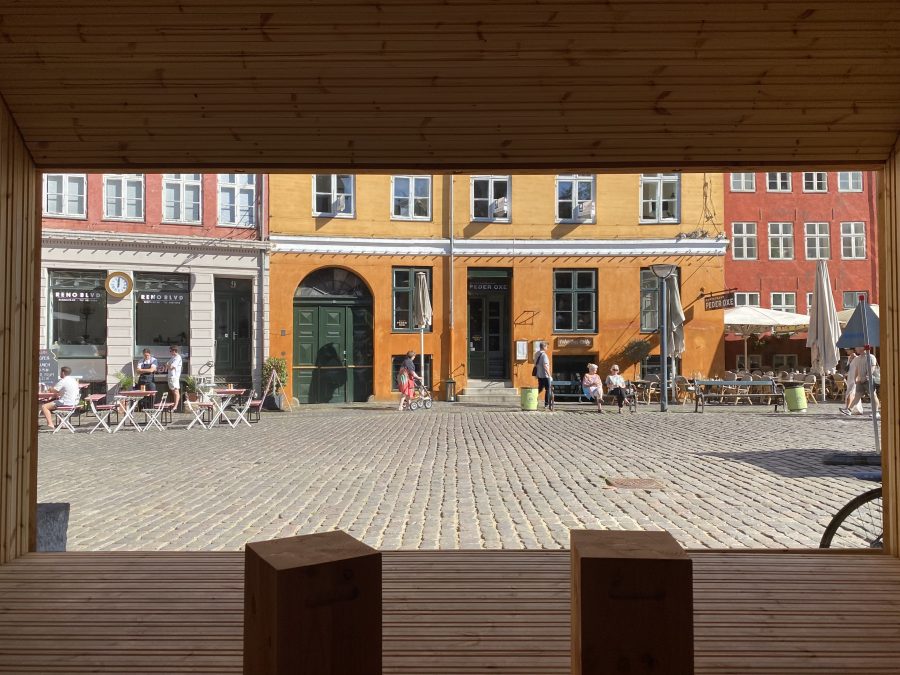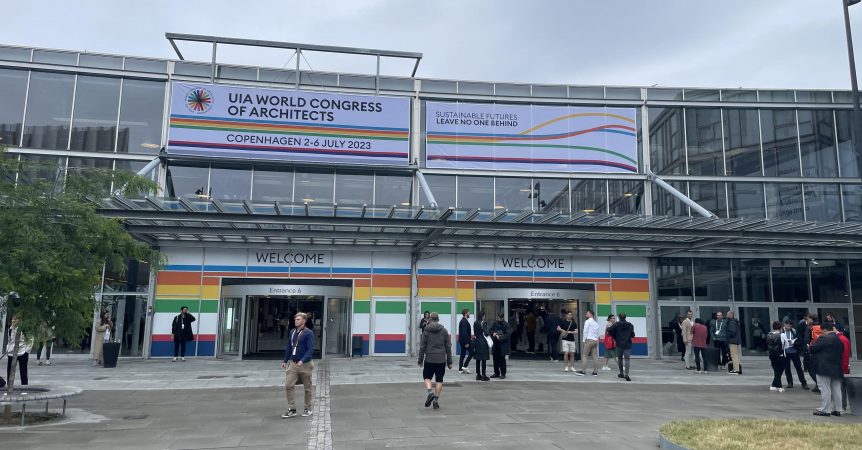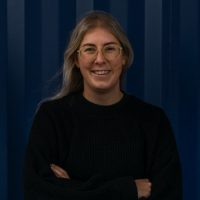The UIA World Congress of Architects Main Entrance - Image by Bettina Werner
Sustainable futures - Leave no one behind: The 2023 UIA Congress hosted by Copenhagen
Jul 11, 2023
About the Author: Bettina Werner is the Co-founder and Project Manager of COurban in Copenhagen, a close partner of Scan Design Foundation. COurban hosts programs and study tours sponsored by Scan Design Foundation for delegations from Washington State to study public life and public space in Denmark. The study tours provide inspiration and strategies in innovative sustainable practices for participants to bring back home.
Key Takeaways from the UIA Congress, July 2023:
As the world’s largest event on sustainable architecture, I was positively surprised by the strong emphasis on process, environment and ecology. The six themes that the sustainable development goals were synthesized into offered talks and discourse on the built environment and ‘traditional’ architecture, but the majority of talks offered interdisciplinary takes – both in regard to speakers and topics explored.
In addition to the extensive daytime program, the week was packed with side events, walking tours and bus tours, as well as a city-wide exhibition of 15 themed pavilions which will be open until November. It was impossible to attend everything, but I will present a comment to each of the congress themes based on the activities I attended.
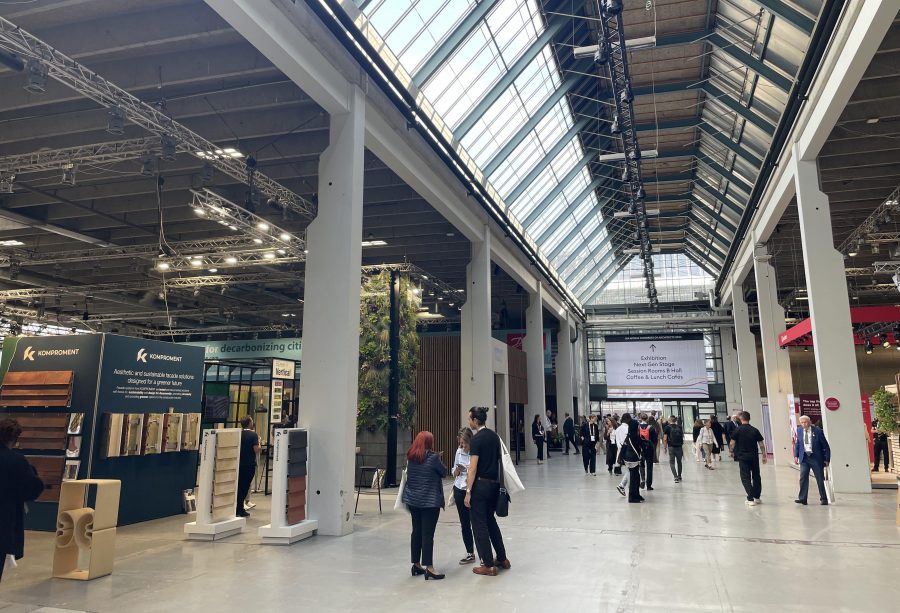
Design for Climate Adaptation
The climate crisis, alongside the biodiversity crisis, was at the top of the agenda for many of the talks and activities at the congress. This was also seen in the open-air exhibition space, with lots of new and innovative materials and products to reduce CO2 and energy consumption, as well as the Nordic Pavilion venue – a small open venue in the main hall which had hosted many shorter dialogues and talks on the topic. In the very well attended keynote and dialogue ’50 Years of Cities for People’, both speakers, Jan Gehl and the city architect of Melbourne, Rob Adams, mentioned the current role of climate adaptation in the recent history of Copenhagen and Melbourne. Jan Gehl described it as the latest phase of urbanism in Copenhagen (from the mid 2010’s), and Rob Adams discussed it in relation to Melbourne’s Urban Forest Strategy. The keynotes and subsequent dialogue also illustrated some of the contextual differences, and the need for local solutions to address climate adaptation – as the challenges it poses takes very different forms in different cities.
Design for Rethinking Resources
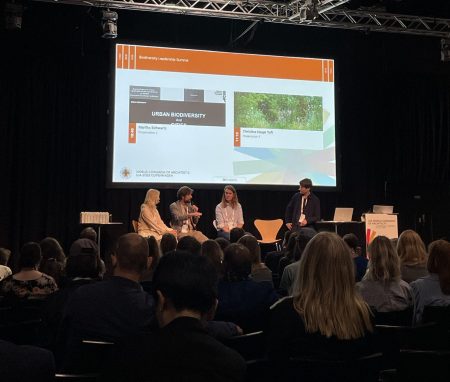
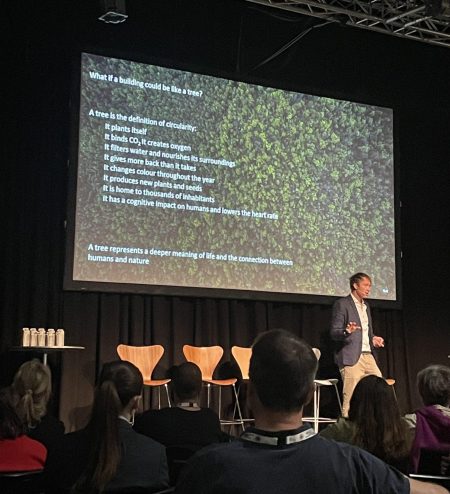
A current challenge on this theme is that we today have an increasing understanding of socio-ecological networks of materials, but we lack tools and models to integrate it in design. Similarly, to building resources, we have an understanding of the ongoing and continuous global biodiversity crisis, yet we don’t know how to combat this when we go to work again on Monday morning. There is today a large disconnect between our resources life and lifespan, and common practices in urban development (the building industry today uses about 50% of all extracted materials annually). Several speakers called for a reevaluation of land in cities where natural land, nature, water, air and biodiversity is worth more, and valued higher than today in relation to other resources and aesthetic value. Therefore, we should ask why we have a currency for CO2, but not for biodiversity.
Anders Lendager, CEO and founder of Lendager Group, presented some takes and solutions to this through some of their project cases. In the spirit of “form follows availability”, they present designs for transformation projects based on the material available on the site already. By doing a thorough resource mapping of the resources they have access to, they emphasize a sustainable, circular process that is resource efficient. As an example, from a transformation project in Germany, they reused 40 escalators from an old shopping mall into a façade of the new development.
Design for Resilient Communities
This topic explored both social and natural aspects of resilience. It was often presented with a difficult starting point, as illustrated by the quote “We have accepted the unacceptable”, taken from the panel discussion ‘How to Design for Equitable Resilience’. Globally, we spend the resources of 1.7 earths every year, and over consumption and production has been common practice in a ‘take, make, dispose’ model of development. Hélène Chartier, Director of Urban Planning and Design at C40, presented a relevant case on this topic. With 20% of the housing stock in Paris empty, it is not sustainable to build more. Instead, there is a need to reevaluate what is existing today. The city of Paris has introduced legislation to prohibit demolition of properties in the city proper – and only allow them to be repurposed and transformed. This isn’t only a housing strategy, or an effort to manage urban density. It also inspires discussion on circularity, economic models, retrofitting, ownership models, property value, and time.
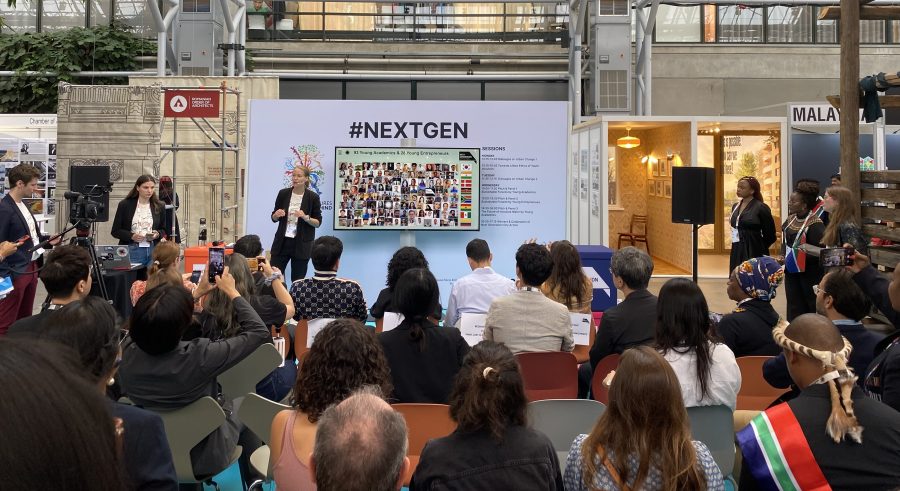
Design for Health and Design for Inclusivity
Health has always been closely related to urban development. Historically, to deal with issues of sanitation in urban-dense living, through to ideas of ‘clean living’ in the Garden City movement, and the Nordic countries emphasis on welfare architecture and landscapes in the 1950’s, 60’s and 70’s. The highest attainable standard of health today, in relation to the built environment and living spaces draws on social and special equity to promote spaces for self-actualization – not an easy task! It creates a whole new set of demands on neighborhoods and living places in regard to the right to actively co-produce and create the space in which you live. For this process to be inclusive, we must also consider equal rights and power, not merely access – as emphasized in one of the panel discussions on universal design and human diversity.
Many activities and talks on the theme ‘Design for Inclusivity’ discussed projects, case examples, and models of co-creation and community engagement, as well as universal design and accessibility. Globally, 1.3 billion people (self-reported) live with a mental or physical disability. During one of the presentations, a point was made that in some context’s disabilities are considered medical issues. Failing to consider mental and physical disabilities in this way, is an obstacle for valuable and active inclusion. It calls for both a reeducation and a reacknowledgement of what a body is, and what it means to be human. One size does not fit all.
There are a range of possible solutions which can improve accessibility for the public. The examples presented include the introduction of legislation to create more housing stock and affordability, more consideration on design briefs and competitions, and the creation of higher minimum standards for accessibility.
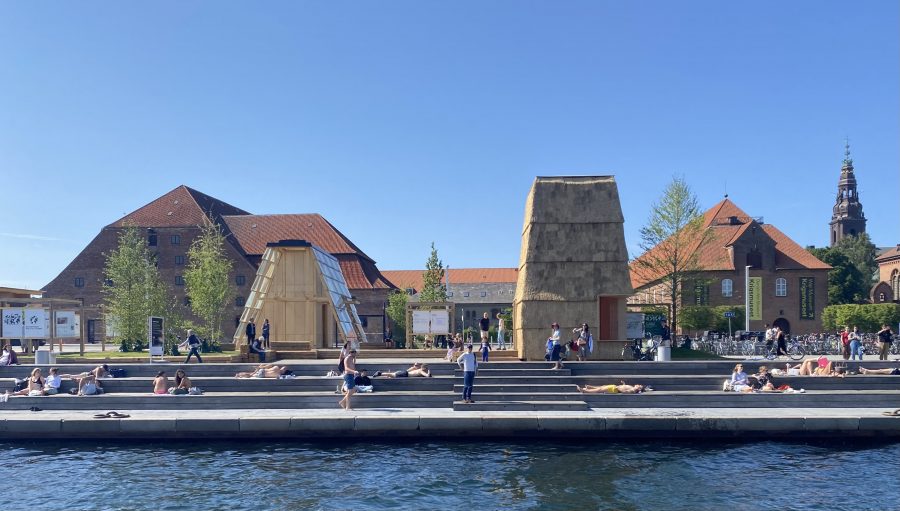
Partnerships for Change
Although few of the talks and activities I attended had a main focus on this theme, it was an underlaying topic in most conversations. Regardless of what urban challenge, case studies, or solutions were discussed – there needs to be cross sectorial and interdisciplinary efforts to address these.
There were many speakers who emphasized public-private partnerships as sustainable models of both ownership and development. Additionally, the many debates and panels were well curated with speakers representing different sectors and different stakeholders. This way, they could manifest the strength of having different perspectives in order to support a constructive dialogue.
Even if current building practices are one of the reasons we find ourselves in an unsustainable situation today, one key takeaway is that urban life is our best chance at a more sustainable future. This also means that urban living must be attractive, with affordability and access to housing, amenities, and nature. As we are starting to see discussions of, and solutions presented to the challenges of materials, resources, and ecology that the built environment poses today, the congress and future UIA events can perhaps help shift the mindset in future city making.
However, as Sir Partha Dasgupta mentioned in the concluding keynote, these challenges will not be solved by this generation. Therefore, it is necessary to actively begin to educate, emphasize, and work for a sustainable future by valuing the earth and her resources higher than today.
